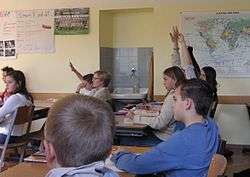Manual communication
Manual communication systems use articulation of the hands (hand signs, gestures) to mediate a message between persons. Being expressed manually, they are received visually, and sometimes tactually (see tactile signing). Manual communication, when it is a primary form of communication, may be enhanced by body language and facial expressions and other forms of communication.


Manual communication is employed in sign languages and in systems that are codes for oral languages (see Manually Coded Language).
Other, simpler forms of manual communication have also been developed. They are neither natural languages nor even a code that can fully render one. They communicate with a very limited set of signals about an even smaller set of topics and have been developed for situations where speech is not practical or permitted, or secrecy is desired.
Environments with manual communication used
- Some cloistered religious communities (see Monastic sign language)
- While scuba diving (see Diving signal)
- In television recording studios
- In loud environments (such as a stock exchange, marketplaces (finger counting), sawmill, or at a horse race - see tic-tac)
- When signalling across distance to a crane driver, ship or plane (see Flag semaphore).
- While hunting (see Kalahari bushmen)
- In the game Charades
- In Rueda de Casino
- Military hand and arm signals are used in combat where stealth or noise makes other forms of communication impractical or undesirable.
- Between lifeguards
- On roads, between vehicle drivers, by other road users such as bicycle and horse riders to signals stops and turns, and by pedestrians to flag a passing taxi or bus
- Gangsters in the Americas use gang signals to signify their allegiance to gangs, and local gang branches.
- In sports fandom (especially in the collegiate level), many universities use hand symbols to show communicative support.
- Chinese number gestures are a method of using one hand to signify the natural numbers one through ten.
See also
External links
- ASL Resource Site Free online lessons, ASL dictionary, and resources for teachers, students, and parents.